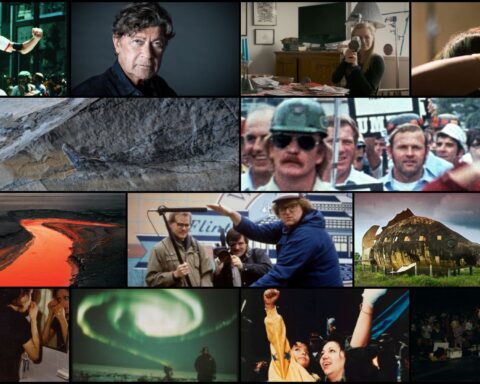Oasis: Supersonic
(UK, 122 min.)
Dir. Mat Whitecross
On the heels of last year’s Academy Award winning Amy Winehouse doc Amy comes Oasis: Supersonic, an astonishingly assembled archival film about British rock legends. Supersonic credits Amy director Asif Kapadia as an executive producer and it’s hard to miss his influence given the impressive dexterity of the film’s form. This doc about the rise of Manchester-based band Oasis stiches together an all-archival portrait of one of the biggest bands of the 1990s. The extensive range of material reverberates with the band’s anthemic hits as Supersonic delivers a thoroughly entertaining concert and an informative portrait of the band’s formative years.
Supersonic chronicles the relationship and rivalry of brothers Liam and Noel Gallagher, the frontmen of Oasis and the ingredients behind their rise and eventual disintegration. The film mostly offers a chronological account of the band’s formation as footage of early rehearsals and gigs finds itself interwoven with audio interviews with the Gallaghers and other bandmates like Paul “Bonehead” Arthurs and Tony McCarroll, as well as the Gallaghers’ mum, Peggy.
The film covers the expected territory of the Oasis’s evolution from dive bar band to worldwide sensation as the members recall gigs and turning points. Supersonic features a playlist of the band’s greatest hits from the title track to “Wonderwall” and “What’s the Story, Morning Glory?” as the Gallaghers and company reflect on the thrill of performing and the high of taking their songs around the world. A lot of the anecdotal history, such as the band’s destructive behaviour in hotel rooms and Noel’s claim to have written “Supersonic” in just a few minutes, are familiar pop culture lore, but Supersonic delivers the story of Oasis with enough energy to appeal beyond the core fan base.
Supersonic also dips into the band’s dark side by using the sibling rivalry between Liam and Noel Gallagher as an essential drive to the arc of Oasis. The tension begins from the early stages as Peggy Gallagher recalls jealousy between the kids with Liam living in the shadow of the elder Noel and antagonising him with every chance he could get. Supersonic shows a challenge of “boys will be boys” take itself to extremes as both Gallagher’s adolescently laugh about their tomfoolery while growing the band.
From Liam bringing home mobs of drunken partyers to the recording studio and belittling Noel’s manliness by nabbing all the girls, to Noel one-upping his brother as the talented songwriter and more than just a pretty face, the brothers explain a tit-for-tat love/hate relationship that brewed into highly publicised scandals and tabloid headlines. Regardless of one’s opinion of the Gallaghers’ character or temperament, this balanced portrait of their unlikability allows one to appreciate the quality of their music and the success of their careers in spite of their toxic relationship.
Instead of interrupting the flow of the archival footage and reiterating in words what one sees in pictures, Supersonic uses the spoken recordings of the interviews to fuel the film. (One downside to omitting the talking heads, however, is that the audio is often difficult to comprehend given the musicians’ deep Manchester accents.) Supersonic might be about Oasis and the Gallaghers, but the real star of the film is the awesome editing by Paul Monahan, which cuts the impressive range of material together like a quickly paced conversation. The elaborate mixing of layers acts as a running commentary that draws out the story underneath the familiar images and wall-to-wall soundtrack of hits.
The film builds to the peak of the band’s career with the record-breaking Knebworth concerts, which remain the most hotly sought-after concert tickets in British history with over 2.5 million applications for attendance. The doc notes the 1996 date as a turning point for the Internet becoming accessible and the bandmates themselves indicate that the success of Oasis wasn’t as strong in the age of smartphones, iThings, MP3s, and personalised consumption of music. Whitecross uses this concert to take the doc a step above, making an obvious claim for the band’s success and uses the swell of enthusiasm for the Knebworth shows to speak to the power of collective experiences. Supersonic positions the group as the last great band before the explosion of the Internet, and as the film ends with thousands of fans rocking at the outdoor concert, the sight resembles, of course, an oasis.
Oasis: Supersonic opens at select Cineplex locations on Thursday, Oct. 27 (see the POV blog for listings).











